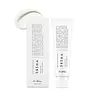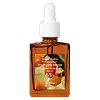What's inside
What's inside
 Key Ingredients
Key Ingredients

 Benefits
Benefits

 Concerns
Concerns

No concerns
 Ingredients Side-by-side
Ingredients Side-by-side

Water
Skin ConditioningPropanediol
SolventGlycerin
HumectantCyclohexasiloxane
Emollient1,2-Hexanediol
Skin ConditioningCaprylic/Capric Triglyceride
MaskingDicaprylyl Carbonate
EmollientPolyglycerin-3
HumectantPolyglyceryl-10 Stearate
Skin ConditioningHydrogenated Polydecene
EmollientLaminaria Japonica Extract
Skin ProtectingEclipta Prostrata Leaf Extract
Skin ConditioningOenothera Biennis Flower Extract
AstringentPerilla Ocymoides Leaf Extract
TonicLavandula Angustifolia Flower Extract
CleansingSargassum Fulvellum Extract
Skin ConditioningCentella Asiatica Leaf Extract
Skin ConditioningGardenia Florida Fruit Extract
Skin ConditioningCalendula Officinalis Flower Extract
MaskingMelia Azadirachta Flower Extract
Skin ConditioningHouttuynia Cordata Extract
Skin ConditioningMelia Azadirachta Leaf Extract
Skin ConditioningCurcuma Longa Root Extract
MaskingOcimum Sanctum Leaf Extract
Skin ConditioningAgave Tequilana Leaf Extract
AstringentCorallina Officinalis Extract
Skin ConditioningHibiscus Sabdariffa Flower Extract
Skin ConditioningSodium Hyaluronate
HumectantHydrogenated Lecithin
EmulsifyingPelargonium Graveolens Flower Oil
MaskingEmpetrum Nigrum Fruit Juice
Skin ConditioningAmmonium Acryloyldimethyltaurate/Vp Copolymer
C14-22 Alcohols
Emulsion StabilisingC12-20 Alkyl Glucoside
EmulsifyingAcrylates/C10-30 Alkyl Acrylate Crosspolymer
Emulsion StabilisingButylene Glycol
HumectantPolyquaternium-51
Skin ConditioningTromethamine
BufferingFructooligosaccharides
HumectantAdenosine
Skin ConditioningBeta-Glucan
Skin ConditioningGlycine Soja Sterols
EmollientHydrolyzed Hyaluronic Acid
HumectantResveratrol
AntioxidantGlucose
HumectantOligopeptide-1
Skin ConditioningCeramide NP
Skin ConditioningPEG-40 Castor Oil
EmulsifyingEthylhexylglycerin
Skin ConditioningCitronellol
PerfumingGeraniol
PerfumingLinalool
PerfumingWater, Propanediol, Glycerin, Cyclohexasiloxane, 1,2-Hexanediol, Caprylic/Capric Triglyceride, Dicaprylyl Carbonate, Polyglycerin-3, Polyglyceryl-10 Stearate, Hydrogenated Polydecene, Laminaria Japonica Extract, Eclipta Prostrata Leaf Extract, Oenothera Biennis Flower Extract, Perilla Ocymoides Leaf Extract, Lavandula Angustifolia Flower Extract, Sargassum Fulvellum Extract, Centella Asiatica Leaf Extract, Gardenia Florida Fruit Extract, Calendula Officinalis Flower Extract, Melia Azadirachta Flower Extract, Houttuynia Cordata Extract, Melia Azadirachta Leaf Extract, Curcuma Longa Root Extract, Ocimum Sanctum Leaf Extract, Agave Tequilana Leaf Extract, Corallina Officinalis Extract, Hibiscus Sabdariffa Flower Extract, Sodium Hyaluronate, Hydrogenated Lecithin, Pelargonium Graveolens Flower Oil, Empetrum Nigrum Fruit Juice, Ammonium Acryloyldimethyltaurate/Vp Copolymer, C14-22 Alcohols, C12-20 Alkyl Glucoside, Acrylates/C10-30 Alkyl Acrylate Crosspolymer, Butylene Glycol, Polyquaternium-51, Tromethamine, Fructooligosaccharides, Adenosine, Beta-Glucan, Glycine Soja Sterols, Hydrolyzed Hyaluronic Acid, Resveratrol, Glucose, Oligopeptide-1, Ceramide NP, PEG-40 Castor Oil, Ethylhexylglycerin, Citronellol, Geraniol, Linalool
Hippophae Rhamnoides Water
MaskingCentella Asiatica Leaf Water
Skin ConditioningNiacinamide
SmoothingButylene Glycol
Humectant1,2-Hexanediol
Skin ConditioningDipropylene Glycol
HumectantWater
Skin ConditioningMethyl Gluceth-20
HumectantMethylpropanediol
SolventBetaine
HumectantTranexamic Acid
AstringentGlycerin
HumectantPentylene Glycol
Skin ConditioningPropanediol
SolventHydroxyethyl Urea
HumectantLaminaria Japonica Extract
Skin ProtectingEclipta Prostrata Leaf Extract
Skin ConditioningFicus Carica Fruit Extract
HumectantCentella Asiatica Extract
CleansingHydrogenated Lecithin
EmulsifyingSodium Hyaluronate
HumectantCarbomer
Emulsion Stabilising3-O-Ethyl Ascorbic Acid
Skin ConditioningC12-14 Pareth-12
EmulsifyingAmmonium Acryloyldimethyltaurate/Vp Copolymer
Xanthan Gum
EmulsifyingTromethamine
BufferingPanthenol
Skin ConditioningEthylhexylglycerin
Skin ConditioningAdenosine
Skin ConditioningDisodium EDTA
Fructooligosaccharides
HumectantBeta-Glucan
Skin ConditioningAscorbic Acid
AntioxidantHydrolyzed Hyaluronic Acid
HumectantCeramide NP
Skin ConditioningAlpha-Arbutin
AntioxidantTocopherol
AntioxidantBifida Ferment Lysate
Skin ConditioningBisabolol
MaskingUbiquinone
AntioxidantHydroxydecyl Ubiquinone
AntioxidantSodium Acetylated Hyaluronate
HumectantHippophae Rhamnoides Water, Centella Asiatica Leaf Water, Niacinamide, Butylene Glycol, 1,2-Hexanediol, Dipropylene Glycol, Water, Methyl Gluceth-20, Methylpropanediol, Betaine, Tranexamic Acid, Glycerin, Pentylene Glycol, Propanediol, Hydroxyethyl Urea, Laminaria Japonica Extract, Eclipta Prostrata Leaf Extract, Ficus Carica Fruit Extract, Centella Asiatica Extract, Hydrogenated Lecithin, Sodium Hyaluronate, Carbomer, 3-O-Ethyl Ascorbic Acid, C12-14 Pareth-12, Ammonium Acryloyldimethyltaurate/Vp Copolymer, Xanthan Gum, Tromethamine, Panthenol, Ethylhexylglycerin, Adenosine, Disodium EDTA, Fructooligosaccharides, Beta-Glucan, Ascorbic Acid, Hydrolyzed Hyaluronic Acid, Ceramide NP, Alpha-Arbutin, Tocopherol, Bifida Ferment Lysate, Bisabolol, Ubiquinone, Hydroxydecyl Ubiquinone, Sodium Acetylated Hyaluronate
 Reviews
Reviews

Ingredients Explained
These ingredients are found in both products.
Ingredients higher up in an ingredient list are typically present in a larger amount.
1,2-Hexanediol is a synthetic liquid and another multi-functional powerhouse.
It is a:
- Humectant, drawing moisture into the skin
- Emollient, helping to soften skin
- Solvent, dispersing and stabilizing formulas
- Preservative booster, enhancing the antimicrobial activity of other preservatives
Adenosine is in every living organism. It is one of four components in nucleic acids that helps store our DNA.
Adenosine has many benefits when used. These benefits include hydrating the skin, smoothing skin, and reducing wrinkles. Once applied, adenosine increases collagen production. It also helps with improving firmness and tissue repair.
Studies have found adenosine may also help with wound healing.
In skincare products, Adenosine is usually derived from yeast.
Learn more about AdenosineAmmonium Acryloyldimethyltaurate/Vp Copolymer (let's call it AAVC for short) is a synthetically created polymer. It's used as a film-forming agent and used to thicken the consistency of products.
AAVC is able to increase the consistency and viscosity of products due to its large molecule size. It also prevents ingredients from separating.
Beta-Glucan is a polysaccharide. It can be derived from the cell walls of seaweed, oats, yeast, and fungi. It hydrates the skin and helps boost your skin's natural barrier.
As an antioxidant, beta-glucan helps fight free-radicals. Free-radicals are molecules that may damage your skin cells, such as pollution.
Studies show this ingredient may be an effective wrinkle reducer as it can deeply penetrate into skin. It has also been show to help with wound healing.
Learn more about Beta-GlucanButylene Glycol (or BG) is used within cosmetic products for a few different reasons:
Overall, Butylene Glycol is a safe and well-rounded ingredient that works well with other ingredients.
Though this ingredient works well with most skin types, some people with sensitive skin may experience a reaction such as allergic rashes, closed comedones, or itchiness.
Learn more about Butylene GlycolCeramide NP is a type of ceramide.
Ceramides are intercellular lipids naturally found in our skin that bonds dead skin cells together to create a barrier. They are known for their ability to hold water and thus are a great ingredient for dry skin.
Ceramides are an important building block for our skin barrier. A stronger barrier helps the skin look more firm and hydrated. By bolstering the skin ceramides act as a barrier against irritating ingredients. This can help with inflammation as well.
If you would like to eat ceramides, sweet potatoes contain a small amount.
Read more about other common types of ceramides here:
Ceramide AP
Ceramide EOP
Eclipta Prostrata Leaf Extract comes from the false daisy plant. False daisy contains antioxidant compounds such as flavonoids.
One study found false daisy to absorb UVA and UVB radiation. However, this should not replace your sunscreen.
False daisy is used in both traditional medicines and foods throughout Southeast Asia and India.
Learn more about Eclipta Prostrata Leaf ExtractEthylhexylglycerin (we can't pronounce this either) is commonly used as a preservative and skin softener. It is derived from glyceryl.
You might see Ethylhexylglycerin often paired with other preservatives such as phenoxyethanol. Ethylhexylglycerin has been found to increase the effectiveness of these other preservatives.
Fructooligosaccharides is an alternative sweetener. It is often derived from the blue agave plant.
This ingredient is a prebiotic and helps to hydrate the skin. Emerging studies are also showing fructooligosaccharides to have antioxidant properties.
As a humectant, Fructooligosaccharides helps draw moisture to the skin, helping to hydrate the skin.
Bananas, onions, garlic, asparagus, jícama, and leeks also contain fructooligosaccharides.
Learn more about FructooligosaccharidesGlycerin is already naturally found in your skin. It helps moisturize and protect your skin.
A study from 2016 found glycerin to be more effective as a humectant than AHAs and hyaluronic acid.
As a humectant, it helps the skin stay hydrated by pulling moisture to your skin. The low molecular weight of glycerin allows it to pull moisture into the deeper layers of your skin.
Hydrated skin improves your skin barrier; Your skin barrier helps protect against irritants and bacteria.
Glycerin has also been found to have antimicrobial and antiviral properties. Due to these properties, glycerin is often used in wound and burn treatments.
In cosmetics, glycerin is usually derived from plants such as soybean or palm. However, it can also be sourced from animals, such as tallow or animal fat.
This ingredient is organic, colorless, odorless, and non-toxic.
Glycerin is the name for this ingredient in American English. British English uses Glycerol/Glycerine.
Learn more about GlycerinHydrogenated Lecithin is created from the hydrogenation of lecithin (a group of phospholipids). Hydrogenation is a chemical reaction between hydrogen and another element.
This ingredient is an emollient and emulsifier. As an emollient, it helps soften skin by trapping moisture within. As an emulsifier, it prevents oil and water ingredients from separating.
Hydrolyzed Hyaluronic Acid is a form of hyaluronic acid. It is created by the hydrolysis of hyaluronic acid with a high molecular weight. Once created, Hydrolyzed Hyaluronic Acid has a low molecular weight.
Low molecular weight HA has been shown to hydrate and increase elasticity of the skin. Increasing elasticity is also associated with reduction of wrinkle depth.
One study found topical low molecular weight hyaluronic acid may be considered for the treatment of rosacea in the adult population. However, we always recommend speaking with a professional about your skin concerns.
Hyaluronic acids are a humectant. This means they draw moisture from the air. Hyaluronic acids help moisturize, soothe, and protect the skin.
Read more about other common forms of hyaluronic acid:
Learn more about Hydrolyzed Hyaluronic AcidLaminaria Japonica Extract comes from a kelp more commonly known as 'sweet kelp'. It is commonly eaten in Japan, Korea, and China.
Sweet kelp is a humectant and helps hydrate your skin. Humectants draw moisture from the air to your skin.
Studies show Laminaria Japonica has antioxidant compounds. Antioxidants may help with anti-aging. Kelp also contains magnesium and zinc, making it great for calming inflammation and redness.
Learn more about Laminaria Japonica ExtractPropanediol is an all-star ingredient. It softens, hydrates, and smooths the skin.
It’s often used to:
Propanediol is not likely to cause sensitivity and considered safe to use. It is derived from corn or petroleum with a clear color and no scent.
Learn more about PropanediolSodium Hyaluronate is hyaluronic acid's salt form. It is commonly derived from the sodium salt of hyaluronic acid.
Like hyaluronic acid, it is great at holding water and acts as a humectant. This makes it a great skin hydrating ingredient.
Sodium Hyaluronate is naturally occurring in our bodies and is mostly found in eye fluid and joints.
These are some other common types of Hyaluronic Acid:
Learn more about Sodium HyaluronateTromethamine helps balance the pH and improve the texture of a product. It is synthetically created.
As an emulsifier, Tromethamine prevents oil and water ingredients from separating. This helps stabilize the product and elongate a product's shelf life. Tromethamine also makes a product thicker.
Tromethamine helps balance the pH level of a product. Normal pH level of skin is slightly acidic (~4.75-5.5). The acidity of our skin is maintained by our glands and skin biome. Being slightly acidic allows our skin to create an "acid mantle". This acid mantle is a thin barrier that protects our skin from bacteria and contaminants.
Oral Tromethanmine is an anti-inflammatory drug but plays the role of masking, adding fragrance, and/or balancing pH in skincare.
1,3-Propanediol, 2-amino-2-(hydroxymethyl)-
Learn more about TromethamineWater. It's the most common cosmetic ingredient of all. You'll usually see it at the top of ingredient lists, meaning that it makes up the largest part of the product.
So why is it so popular? Water most often acts as a solvent - this means that it helps dissolve other ingredients into the formulation.
You'll also recognize water as that liquid we all need to stay alive. If you see this, drink a glass of water. Stay hydrated!
Learn more about Water